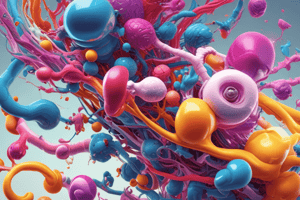Podcast
Questions and Answers
What is the primary role of adenosine triphosphate (ATP) in cells?
What is the primary role of adenosine triphosphate (ATP) in cells?
- Transport of oxygen
- Source of structural support
- Carrier of energy (correct)
- Storage of genetic information
How much energy is released during the hydrolysis of one mole of ATP?
How much energy is released during the hydrolysis of one mole of ATP?
- 8.2 kcal
- 10.5 kcal
- 7.3 kcal (correct)
- 3.1 kcal
Which process uses the energy from the flow of electrons to produce ATP?
Which process uses the energy from the flow of electrons to produce ATP?
- Fermentation
- Oxidative phosphorylation (correct)
- Beta-oxidation
- Glycolysis
From which molecule is Acetyl CoA derived in carbohydrate catabolism?
From which molecule is Acetyl CoA derived in carbohydrate catabolism?
What is the function of the electron transport chain in mitochondria?
What is the function of the electron transport chain in mitochondria?
What is produced at the end of protein catabolism?
What is produced at the end of protein catabolism?
Which type of cellular work involves the contraction of muscle cells?
Which type of cellular work involves the contraction of muscle cells?
What is metabolism primarily defined as?
What is metabolism primarily defined as?
Which of the following correctly describes a catabolic reaction?
Which of the following correctly describes a catabolic reaction?
How are metabolic pathways characterized?
How are metabolic pathways characterized?
Which statement about the Krebs cycle is true?
Which statement about the Krebs cycle is true?
What is the primary output of catabolic reactions?
What is the primary output of catabolic reactions?
In which cellular location does oxidative phosphorylation occur?
In which cellular location does oxidative phosphorylation occur?
What term describes metabolic pathways that serve both anabolic and catabolic functions?
What term describes metabolic pathways that serve both anabolic and catabolic functions?
Which of the following correctly illustrates an anabolic reaction?
Which of the following correctly illustrates an anabolic reaction?
Flashcards are hidden until you start studying
Study Notes
Metabolism
- The sum of all chemical changes occurring in a cell, tissue, or the body.
- Composed of metabolic pathways.
- Each pathway is a multistep sequence of reactions where the product of one reaction serves as the substrate for the next.
- Each reaction is catalyzed by a specific enzyme.
Catabolic, Anabolic, and Amphibolic Pathways
- Catabolic (degradative) pathways: Break down complex molecules (proteins, polysaccharides, and lipids) into simpler molecules, releasing energy.
- Anabolic (synthetic) pathways: Build complex molecules from simpler precursors, requiring energy input.
- Amphibolic pathways: Combine both catabolic and anabolic features, functioning in both breakdown and synthesis.
Metabolic Map
- A visual representation of interconnected metabolic pathways.
Catabolic & Anabolic Reactions
- Catabolic Reactions:
- Break down complex molecules.
- Yield energy in the form of ATP from the degradation of energy-rich fuel molecules.
- Anabolic Reactions:
- Form complex end products from simple precursors.
- Utilize energy for synthesis, e.g., glycogen from glucose and proteins from amino acids.
Stages of Catabolism
- Stage 1: Breakdown of macromolecules into smaller units.
- Stage 2: Conversion of smaller units into acetyl CoA.
- Stage 3: Oxidation of acetyl CoA in the citric acid cycle.
- Stage 4: Electron transport chain and oxidative phosphorylation.
ATP (Adenosine Triphosphate)
- The primary energy carrier in cells.
- Hydrolysis of the terminal phosphate group (ATP -> ADP + Pi) releases 7.3 kcal of energy per mole of ATP.
- Powers cellular work:
- Mechanical work (muscle contraction)
- Transport work (pumping substances across membranes)
- Chemical work (driving endergonic reactions like polymer synthesis)
Mitochondria
- The "powerhouse" of the cell, responsible for generating ATP through electron transport chain and oxidative phosphorylation.
Electron Transport Chain
- Occurs in the mitochondria.
- Flow of electrons from NADH & FADH2 (through electron carriers CoQ and cytochromes) to oxygen generates energy.
- This energy is used for phosphorylation of ADP to ATP.
Oxidative Phosphorylation
- The process of generating ATP from the oxidation of NADH and FADH2, coupled with the phosphorylation of ADP to ATP in the mitochondria.
Catabolism of Carbohydrates
- Dietary carbohydrates or glycogen are broken down to glucose.
- Glycolysis: Glucose is converted to pyruvate in the cytoplasm.
- Pyruvate: Converted to acetyl CoA in the mitochondria.
- Citric Acid Cycle: Acetyl CoA is oxidized, generating NADH and FADH2 in the mitochondria.
- Electron Transport Chain: Electron flow from NADH and FADH2 to oxygen generates ATP via oxidative phosphorylation.
Lipid Catabolism
- Triglycerides are broken down into fatty acids.
- Fatty acids are converted to acetyl CoA.
- Acetyl CoA enters the citric acid cycle, leading to ATP production.
Protein Catabolism
- Proteins are broken down into amino acids.
- Deamination: Removal of the amino group (nitrogen) from amino acids.
- Deaminated amino acids can be used in the synthesis of other compounds or catabolized to acetyl CoA, entering the citric acid cycle for ATP production.
- Nitrogen is excreted as urea.
Studying That Suits You
Use AI to generate personalized quizzes and flashcards to suit your learning preferences.




